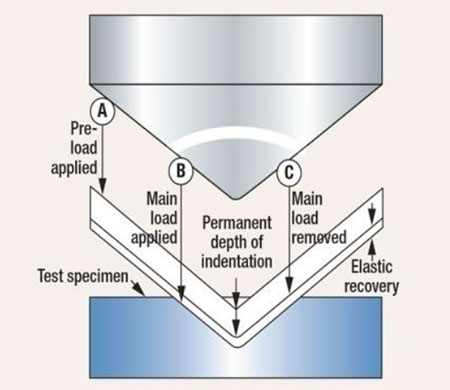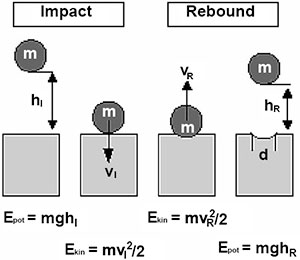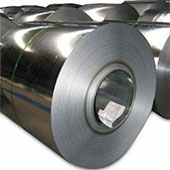Metals are solid materials at room temperature. One exception is mercury which is also a metal. The density and melting points of metals are high. The typical characteristics metals exhibit and are made use of in manufacturing are:
- Hardness
- Ductility
- Malleability
- Thermal conductivity
- Electrical conductivity
Metals are sonorous which means they produce ringing sounds when hit with a hard object. They also possess a lustrous property that reflects light.
1. Hardness
Resistance to wear and tear is directly proportional to the hardness of the material. Harder the material is, the longer its durability. Hardness represents the strength of a material.
Knowing metal hardness is important to understand the metal and to ensure part functionality. For example, a hammer made from low carbon steel may cost less but wears out much faster. A knife made from stainless steel will last much longer than the one made of mild steel.
Hardness Testing:
There are three main methods to measure the hardness of materials.
- Scratch hardness
- Indentation Hardness
- Rebound Hardness
Scratch Hardness:

Scratch Hardness Test (Image source)
The Scratch hardness test determines the hardness of a surface against scratches, friction, or abrasions. The test is conducted to measure the resistance to friction against a sharp object quantitatively. The resistance measurements are compared against standard scales. This test is commonly used to test the adherence quality of painting, powder coating processes.
Indentation Hardness

(Forge Magazine)
Indentation Hardness Test (Image source)
The Indentation hardness test is to determine the hardness of the material against deformation. The level of indentation quantifies the hardness level. In practice, drop tests are conducted in product samples to test reliability after a fall from predetermined heights. We can understand the level of protection an enclosure cover or a packaging box offers to the hardware inside, which is meant to be protected.
Rebound Hardness:
It is a measure of the elasticity of the material. It measures the height of the bounce of an object under certain conditions. Indentation hardness tests are used to determine the hardness of a material to resist deformation. For example, electronic products are subjected to shock and bump tests to test the rigidity of electrical and mechanical connections.

Rebound Test (Image source)
Commonly adapted tests for measuring hardness tests are the Rockwell hardness test, Vickers Hardness test, and Brinell hardness test.
2. Ductility
The ductility of a material is the ability to stretch under tensile stress. Understanding ductility properties helps to know how far the material can be stretched considerably without giving away. It is a measure of the deformation of a material under pulling pressure. It is the ductile property of the material that is observed in most of the sheet metal products involving processes such as wire forming, punch forming, shallow drawing, and so on.

Tensile Stress (Image source)

Ductility is a measure of material withstanding tensile stress
 Ductility allows material to stretch down. (Image source)
Ductility allows material to stretch down. (Image source) Progressive thinning of wire.
Progressive thinning of wire. A wire drawing unit.
A wire drawing unit.3. Malleability
Malleability is the ability of a material to deform under compressive stress. It means the material can be shaped to desired shapes by applying pressure. The malleability property of the material allows the conversion of thicker sheets into thin sheets by rolling or hammering. It is the ductile and malleable properties of sheet metals used in many production methods, mainly forming.

Compressive Stress (Image source)

Malleability is a measure of material withstanding compressive stress.
When subjected to tensile force, a ductile material gets stretched into longer shapes such as rods and wires without undergoing fracturing. When subjected to a compressive force, a malleable material gets deformed into thin sheets or forms new shapes. Both ductility and malleability are the two main characteristic properties of metals. Malleability combined with ductility allows materials to transform into different shaped components.
Relation between ductility and strength

Stress-Strain Diagram (Image source)
Too high or too low ductility is also not desirable.
4. Electrical Conductivity
Electrical conductivity is a measure of how well the conduction of electricity takes place inside the material. Lower the resistance of the material to allow electricity to pass, higher the rate of travel. Electrical and electronic products need the least electric resistant paths for the efficient function of the product. Almost all power electronics products will have bus bars for efficient conduction of electricity. Designers can make use of interesting patterns in arranging the bus bars.
5. Thermal Conductivity
Heat is a big deterrent for the proper function of electronics. Beyond a certain temperature, say 45 – 50 deg C, electronic components start displaying erratic behaviour. It is a must to dissipate thermal energy generated by electronic components as much and as faster possible for the reliability of the components and the product. Metals, in particular copper, aluminium have excellent thermal conductivity properties. Aluminium, in particular, is widely used in heat sink designs to dissipate away heat from electronic circuits. Generally, good electrical conductors are also good thermal conductors.


 Marteau Design
Marteau Design Tool Steel Products
Tool Steel Products Whistledesign
Whistledesign  KA-BAR U.S. Army Knife 1219
KA-BAR U.S. Army Knife 1219 Rolled Sheet
Rolled Sheet  Stretched Tin
Stretched Tin Compressed Dome (wallpaperflare.com)
Compressed Dome (wallpaperflare.com) Twisted strand cable and Busbar.
Twisted strand cable and Busbar. Shan power cable)
Shan power cable) Cast Heatsink.
Cast Heatsink. Fabricated Heatsinks.
Fabricated Heatsinks. 3D printed Heatsink.
3D printed Heatsink.